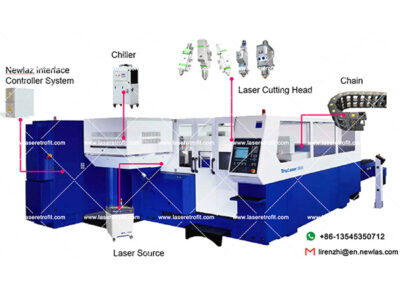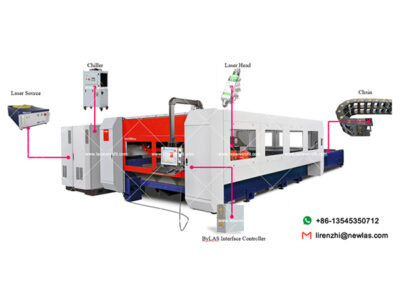In general, the material cutting needs to use auxiliary gas, mainly involving the gas type and pressure.
The gas type, air pressure, nozzle diameter and geometric structure influence the edge roughness and the generation of burrs.
The gas consumption depends on the nozzle diameter and air pressure. When the cutting pressure is below 0.5MPa, it is low pressure, and above 2MPa is high pressure.
Usually, the auxiliary gas and the laser beam are ejected coaxial, which can protect the focusing lens from being polluted while blowing away the bottom slag at the cutting zone.
The types of gases used in general laser cutting are oxygen, nitrogen and air. Different cutting materials require different auxiliary gases.
- The oxygen is mainly used for tapping, high-speed cutting of carbon steel and stainless steel plate and oxidation cutting of highly reflective materials. As an auxiliary gas, oxygen can also make metal to burn. The laser cutting machine uses its oxidation reaction heat for efficient cutting, but it also produces oxide film on the cutting surface.
- Nitrogen is mainly used in stainless steel plate cutting without oxidation and galvanized sheet metal cutting without slag;
- The air is mainly used for aluminum and galvanized steel plate cutting without slag and ordinary non-metal cutting.
The auxiliary gas pressure varies with the type of gas used, cutting material, plate thickness and laser output form (CW/pulse).
The auxiliary gas pressure affects the adhesion of slag, the quality of the cutting surface and the size of the heat affected area.
The air pressure condition of the nozzle outlet during processing is shown in the following table:
| Tapping (MPa) | Sheet Metal O2 Cutting (MPa) | Thick Mild Steel O2 Cutting (MPa) | Stainless Steel O2 Cutting (MPa) | Alumiunum Air Cutting (MPa) |
| 0.02-0.05 | 0.1-0.3 | 0.05-0.1 | 0.6-1.5 | 0.6-1.0 |
Under the premise of determining the auxiliary gas type, the gas pressure size is an extremely important factor.
- If the auxiliary gas pressure is too high, the vortex will be formed on the surface of the workpiece to weaken the ability of the airflow to remove the molten material which causes the cutting surface rougher and the slit wider.
- If the auxiliary gas pressure is too low, the melting material of the incision is not blown and generate slag on the back of the cut material.
Therefore, there is an optimum value for auxiliary gas pressure.
When cutting thin materials at high speed, high gas pressure is required to prevent the backside of the incision from producing slag. When the thickness of the material is increased or the cutting speed is slow, the gas pressure should be reduced appropriately.
Taking laser cutting of stainless steel plate as an example, in the process of cutting, auxiliary gas can cool the adjacent areas of cutting seam to reduce the heat impact zone and prevent the burner from damaging the lens. In addition, using nitrogen as auxiliary gas, it can make molten metal have good fluidity.
cr: machinemfg






